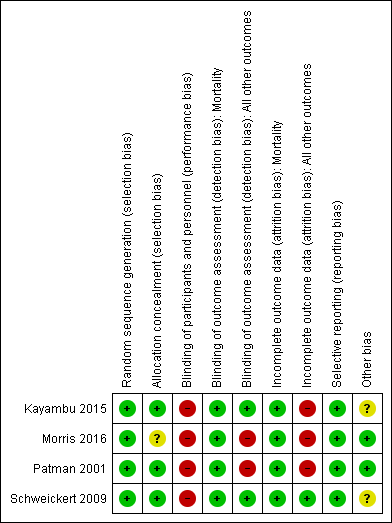| Item | Morris 2016 | Kayambu 2015 | Patman 2001 | Schweickert 2009 |
| Brief name | Standardized rehabilitation therapy | Early physical rehabilitation in ICU | Physiotherapy | Early physical and occupational therapy in mechanically ventilated, critically ill patients |
| What
(Materials and Procedures) | 3 exercise types: -
passive ROM: 5 repetitions for each upper and lower extremity joint; -
physiotherapy: bed mobility, transfer training, and balance training. These exercises included transfer to the edge of the bed; safe transfers to/from bed, chair, or commode; seated balance activities; pre‐gait standing activities (forward and lateral weight shifting, marching in place); and ambulation; -
progressive resistance exercise: included dorsiflexion, knee flexion and extension, hip flexion, elbow flexion and extension, and shoulder extension. Resistance was added through the use of elastic resistance bands (TheraBand, Hygienic Corporation). Both the physiotherapy and resistance training targeted lower extremity functional tasks and ADLs. See trial protocol (supplement to article) for more details. | Specific equipment not reported. Procedures mentioned include: arm or leg ergometry; passive, active and resisted ROM exercises; bed mobility activities; sitting and standing balance exercises; transfer training; pre‐gait exercises; ambulation with assistance; electrical muscle stimulation; and Tilt table | Specific equipment was not reported. Procedures mentioned include: positioning; manual hyperinflation; endotracheal suctioning; thoracic expansion exercises; and upper limb exercises | Specific equipment was not reported. Procedures mentioned included: passive, active‐assisted and active ROM exercises; bed mobility activities; sitting balance exercises; ADL exercises to promote increased independence with functional tasks; transfer training; pre‐gait exercises; and ambulation |
| Who provided | Physiotherapist, ICU nurse, and nursing assistant | ICU research physiotherapist | Team of physiotherapists under the guidance of the principal investigator | An occupational therapist and a physical therapist |
| Where | One medical ICU, Medical Centre, North Carolina, USA | Quaternary‐level general ICU, Australia | Surgical ICU, Perth, Australia | Two medical ICUs: Chicago, USA and Iowa City, USA |
| When and how much | 3 separate sessions every day of hospitalization for 7 days per week, from enrolment through to hospital discharge | 30 min 1‐2 times/day within 48 h of diagnosis of sepsis until discharge from the ICU | 1‐2 interventions during the first 24 h of mechanical ventilation | Interventions were synchronized with daily interruption of sedation. Each morning within 48‐72 h of intubation until return to previous level of function or discharge from the ICU |
| Tailoring and progression | The participant's level of consciousness determined whether they were considered suitable to receive the physiotherapy or progressive resistance exercise, as did their ability to complete the exercises. When participants were unconscious, the 3 sessions consisted of passive ROM. As consciousness was gained, physiotherapy and progressive resistance exercise was commenced. Participants did not need to be free of mechanical ventilation to begin any of the exercise sessions | Interventions were tailored, planned, administered and progressed at the discretion of the physiotherapist, participant acuity of illness and level of co‐operation | Not reported | Progression of interventions depended on participant tolerance and stability. |
| Modification of intervention throughout trial | Not reported | Not reported | Not reported | Not reported |
| Fidelity (strategies to improve) | Not reported | Not reported | Not reported | Not reported |
| Fidelity (extent) | The mean percentage of study days that participants received therapy was 87.1% (SD 18.4%) for passive ROM; 54.6% (SD 27.2%) for physiotherapy; and 35.7% (SD 23%) for progressive resistive exercise. The median days of delivery of therapy per participant was 8.0 (IQR, 5.0‐14.0) for passive ROM, 5.0 (IQR, 3.0‐8.0) for physiotherapy, and 3.0 (IQR, 1.0‐5.0) for progressive resistance exercise | All participants adhered and remained enrolled for an average of 11.4 days. No further details. | Not reported | Therapy occurred on 87% of the days on the study for all participants in the intervention group and on 95% of the days on the study for 22/55 (40%) of participants in the control group |




